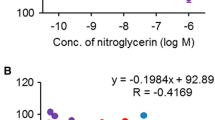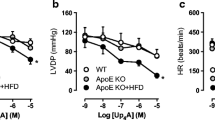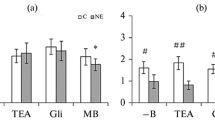Abstract
The mechanism of ergonovine-provoked coronary vasospasm is poorly understood. We tested the effect of ergonovine in perfused hearts from normal and cholesterol-fed (18 weeks, 2% cholesterol diet) rabbits in a constant-flow Langendorff perfusion. Aortic perfusion pressure was monitored to measure coronary vascular resistance, and left ventricular pressure was measured with an isovolumetric balloon in the left ventricle. Control coronary vascular resistance was 1.12±0.11 mm Hg/ml/min in hearts from normal rabbits and 1.53±0.16 mm Hg/ml/min in hearts from cholesterol-fed rabbits (n=9 each,\(\bar x\), p<0.05). The cholesterol content of aortae from cholesterol-fed rabbits was markedly increased (432±85 mg/g protein vs. 14.9±8.2 in controls, p<0.001; for coronaries: 396±136 mg/g protein vs. 125±25, p<0.05). In both groups, increases in coronary vascular resistance were observed with vasopressin (40 IU/1) and phenylephrine (30 μM) and decreases with adenosine (10 μM), isoprenaline (0.1 μM) and 30 sec stopflow (all p<0.05). Ergonovine maleate (10 μM) and serotonine (10 μM) did not increase coronary vascular resistance.
Although in whole heart perfusion small changes in the caliber of epicardial vessels may not be detectable, changes severe enough to produce measurable changes in total coronary resistance were not found. Therefore the absence in our model of an increase in coronary vascular resistance after ergonovine is not compatible with a local direct mechanism in epicardial arterial wall, even when sensitized by a high cholesterol diet.
Zusammenfassung
Der Mechanismus des durch Ergonovin provozierten koronaren Vasospasmus ist weitgehend unklar. Wir untersuchten die Wirkung von Ergonovin an Herzen von normalen und cholesterol-gefütterten Kaninchen (18 Wochen, 2% Cholesterol-Fütterung, deutliche Atheromatose) in einer Langendorff-Perfusion mit konstantem Fluß. Der aortale Perfusionsdruck diente als Maß des Koronarwiderstandes, der linksventrikuläre Druck wurde über einen Ballon im linken Ventrikel gemessen. Unter Kontrollbedingungen betrug der Koronarwiderstand 1,12±0,11 mm Hg/ml/min für Normalherzen und 1,53±0,16 mm Hg/ml/min für Herzen von cholesterolgefütterten Kaninchen (jeweils n=9,\(\bar x\), p<0,05). Nach Cholesterolfütterung war der Cholesterolgehalt der Aorten auf 432±85 mg/g Protein erhöht (Kontrolle 14,9±8,2, p<0,001) und in den Koronarien auf 396±136 mg/g Protein (Kontrolle 125±25, p<0,05). In beiden Gruppen wurde ein Anstieg des Koronarwiderstands mit Vasopressin (40 IU/1) und Phenylephrin (30 μM) und Absinken mit Adenosin (10 μM), Isoprenalin (0,1 μM) und 30 s Abklemmen beobachtet. Ergonovinmaleat und Serotonin (je 10 μM) führten zu keinem Anstieg des Koronarwiderstands.
Obwohl in unserem Modell kleine Veränderungen im Kaliber epikardialer Gefäße unentdeckt bleiben können, wurden meßbare Veränderungen des Koronarwiderstands — wie sie notwendig wären, um in vivo eine Ischämie auszulösen-unter Ergonovin nicht gefunden. Das Fehlen eines Anstiegs im Koronarwiderstand nach Ergonovin erscheint nicht vereinbar mit einem lokalen direkten Angriffspunkt an epikardialen Koronargefäßen, auch nicht nach Cholesterol-Fütterung.
Similar content being viewed by others
References
Blomhoff, J. P.: Serum cholesterol determination by gas-liquid chromatography. Clin. Chim. Acta43, 257–265 (1973).
Bongrani, S., M. Di Donato, O. Visiolini, P. Mantovani: Effect or ergometrine on contractile force of guinea pig isolated heart: antagonism by cimetidine. Agents Actions9, 15–17 (1979).
Chan, C. T., H. Wells, D. M. Kramsch: Suppression of calcific fibrous-fatty plaque formation in rabbits by agents not affecting elevated serum cholesterol levels. Circulat. Res.43, 115–125 (1978).
Prinzmetal, M., R. Kennamer, R. Kerliss, T. Wada, R. Bor: Angina pectoris. 1. A variant form of angina pectoris. Amer. J. Med.27, 375–388 (1959).
Curry, R. C., C. J. Pepine, M. B. Sabom, C. R. Conti: Similarities of ergonovine-induced and spontaneous attacks of variant angina. Circulation59, 307–312 (1979).
Feigl, E. O.: Parasympathetic Control of Coronary Blood Flow in Dogs. Circulat. Res.25, 509–519 (1969).
Ferrari, R., S. Bongrani, R. Raddino, F. Di Lisa, F. Cucchini, O. Visioli: Effects of phenoxybenzamine, nitroglycerine, atropine and verapamil on ergonovine-induced increase of coronary resistances in the isolated rabbit heart. J. Mol. Cell. Cardiol.12, Suppl. 1, 40 (abstract) (1980).
Folch, J., M. Lees, G. H. Sloane Stanley: A simple method for the isolation and purification of total lipides from animal tissue. J. Biol. Chem.226, 497–509 (1957).
Ginsburg, R., M. R. Bristow, D. C. Harrison, E. B. Stinson: Studies with isolated human coronary arteries. Chest78, (suppl.) 180–186 (1980).
Henry, P. D., M. Yokoyama: Supersensitivity of atherosclerotic rabbit aorta to ergonovine. Mediation by a serotonergic mechanism. J. Clin. Invest.66, 306–313 (1980).
Hillis, L. D., E. Braunwald: Coronary artery spasm. New Engl. J. Med.229, 695–703 (1978).
Heupler, F., M. Proudfit, M. Razavi, E. Shirey, R. Greenstreet, W. Sheldon: Ergonovine maleate provocative test for coronary arterial spasm. Amer. J. Cardiol.41, 631–640 (1978).
Holtz, J., W. Held, O. Sommer, G. Kühne, E. Bassenge: Ergonovine-induced constrictions of epicardial coronary arteries in conscious dogs: alpha-adrenoceptors are not involved. Basic Res. Cardiol.77, 278–291 (1982).
Karp, D., S. Rinzler, J. Travell: Effects of ergometrine (ergonovine) on the isolated atherosclerotic heart of the cholesterol-fed rabbit. Brit. J. Pharmacol.15, 333–344 (1960).
Lowry, O. H., N. J. Rosebrough, A. L. Farr, R. J. Randall: Protein measurement with the folin phenol reagent. J. Biol. Chem.193, 265–275 (1951).
Maseri, A., S. Severi, M. De Nes, A. L'Abbate, M. Marzilli, A. Ballestra, O. Parodi, A. Biagini, A. Distante: Variant angina: one aspect of a continuous spectrum of vasospastic myocardial ischemia. Amer. J. Cardiol.42, 1019–1035 (1978).
Maseri, A., A. Pesola, M. Marzilli, S. Severi, O. Parodi, A. L'Abbate, A. Ballestra, G. Maltinti, D. De Nes, A. Biagini: Coronary vasospasm in angina pectoris. Lancet1977/II, 713–717.
Meller, J., A. Pichard, S. Dack: Coronary Arterial Spasm in Prinzmetals' Angina: A proved hypothesis. Amer. J. Cardiol.37, 938–940 (1976).
Müller-Schweinitzer, E.: The mechanism of ergometrine-induced coronary arterial spasm: in vitro studies on canine arteries. J. Cardiovasc. Pharmacol.2, 645–655 (1980).
Neutze, J. M., F. Wyler, A. M. Rudolph: Use of radioactive microspheres to assess distribution of cardiac output in rabbits. Amer. J. Physiol.215, 486–495 (1968).
Rinzler, S., J. Travell, D. Karp, D. Charleson: Detection of coronary atherosclerosis in the living rabbit by the ergonovine stress test. Amer. J. Physiol.184, 605–612 (1956).
Ross, B. D.: Perfusion techniques in biochemistry. Clarendon Press Oxford, 258–317 (1972).
Senges, J., E. Weihe, J. Bachmann, D. Pelzer, H. Nimmrich, W. Kübler: Effects of hypercholesterolaemia without ischaemia on some electrophysiological and ultrastructural properties of the rabbit heart. J. Mol. Cell. Cardiol.13, 253–264 (1981).
Wissler, R. W., D. Vesselinovitch: Evaluation of animal models for the study of the pathogenesis of atherosclerosis. In: International Symposium on the state of prevention and therapy in human atherosclerosis and in animal models. W. H. Hauss, 13–29. Westdeutscher Verlag (Opladen 1978).
Author information
Authors and Affiliations
Additional information
Supported in part by the Deutsche Forschungsgemeinschaft (Ar 139/2)
Rights and permissions
About this article
Cite this article
v. Arnim, T., Crea, F., Chierchia, S. et al. Effects of vasoactive stimuli on coronary vascular resistance in isolated perfused rabbit hearts: No vasospastic response to ergonovine with or without atherogenic diet. Basic Res Cardiol 78, 415–422 (1983). https://doi.org/10.1007/BF02070165
Received:
Issue Date:
DOI: https://doi.org/10.1007/BF02070165




